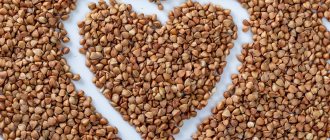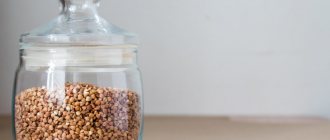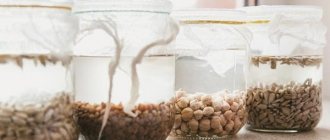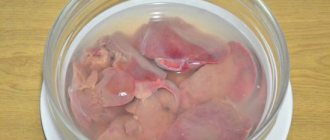The boom in healthy eating and a conscious approach to food choice is associated not only with fashion and popular trends, but with people’s desire to maintain and increase their health. Classic diets quickly tire you out and do not give you strength, but a reasonable approach to your diet, combined with the proper introduction of healthy, tasty foods into it, helps you get excellent results.
A striking example of such a rethinking of the food set can be the use of sprouted green buckwheat. Contrary to popular belief it is not difficult to germinate this cereal , and the resulting product pleases with both an excellent set of vitamins and microelements and a pleasant taste.
How to germinate green buckwheat at home
Many people like to eat grains such as buckwheat. It comes in two types: regular, heat-treated, and green, which is the healthiest. Today I will tell you how to germinate green buckwheat at home. It is very good to add to vegetable salads with herbs and oil.
Ingredients:
- green buckwheat;
- water (filtered).
Cooking method step by step:
- Only green buckwheat is chosen for germination, since it does not undergo heat treatment. This means that it retains all the useful substances, of which the seed itself contains most (90%), and the rest is the sprout (10%). Thus, if you sprout buckwheat, the sprout and nutrients are activated. It will also be easier for the stomach to digest such cereals, and the body will receive maximum benefit from the food consumed.
- Green buckwheat is germinated in 2 stages. The first is when it is saturated with water, and the second is germination.
- First stage. Take a clean and dry liter jar, pour the required amount of cereal into it and fill it with clean drinking water. Then shake thoroughly, but gently so as not to damage the seed. This is necessary in order to remove the buckwheat that remains on the surface, since it will not produce any shoots.
- Next, add water and excess cereal. Then fill it again with clean drinking water and leave it to soak in moisture. This stage is best done in the evening before bed.
- Second phase. So, 3 to 12 hours of soaking the buckwheat have passed. Thoroughly shake the cereal with the water in which it was soaked. A lot of mucus has appeared, which definitely needs to be drained.
- Pour the cereal again with clean water and add salt, straining through a sieve. We do this 2 times.
- After this, let’s leave the buckwheat to grow without water, since it has been sufficiently saturated with moisture and light. It is best to do this in a spacious plastic container, as more air enters it and it grows better.
- You can’t put it too much in the sun, otherwise the buckwheat will dry out. We'll just leave it to grow on the kitchen counter, away from direct sunlight. Be sure to rinse it once every 12 hours to wash away any mucus that has formed. We do this 2 times.
- 24 hours have passed since germination and 36 hours since soaking. Green buckwheat is ready to eat. But before you start eating, you need to rinse it with clean drinking water 2 times so that it becomes clean and tasty.
- It is better to store it in the same container, because access to air allows the buckwheat to grow faster and will not allow it to disappear. If you want to slow down the appearance of buckwheat sprouts, then put it in the refrigerator open. But if mold appears on the surface, it must be thrown away.
Sprouted buckwheat is good to use in preparing salads and desserts. And also, if dried, as a crunchy addition to sweets. This is a very useful product that absolutely everyone will like. I wish you good health and good mood.
Preparatory work
Before planting seeds, you need to choose the right container. Plastic plates and bowls are not suitable: the material does not allow air to pass through and can cause the seeds to sour. It is better to use a container made of porcelain, glass or ceramics. You also need to choose a shallow and wide bowl for washing and soaking the grain. Before planting, the seeds are washed several times - the water should remain clean. For soaking, it is better to prepare spring or clean filtered water, but not boiled water. You will also need a small piece of gauze fabric.
How to germinate green buckwheat in 24 hours (the easiest way)
Green buckwheat is the same cereal as the popular and well-known brown one. The only difference is that brown cereals are subjected to heat treatment, after which they acquire a brown tint. It is ideal for meat, chicken, minced meat and fish dishes. Not many people know that green buckwheat can be sprouted. This process is very exciting and interesting, so children will be delighted.
Ingredients:
- green buckwheat – 500 gr;
- purified water.
Cooking method:
- At the very beginning, green buckwheat must be poured into a bowl.
- Pour running water into the cereal through a sieve.
- Buckwheat must be mixed with your hands, at this time mucus will begin to release.
- After this, you need to pour the cereal onto a sieve and continue to rinse it.
- It is worth rinsing until it is no longer slippery.
- At the end, you need to let the water drain a little and pour the buckwheat into a convenient container.
- Pour purified water at room temperature into the buckwheat so that it completely covers the grain.
- Without covering with a lid, leave the buckwheat in this form for 60 minutes at room temperature.
- After the specified time has passed, the buckwheat has activated; the water must be drained from it.
- Transfer the buckwheat again to a sieve and rinse thoroughly again.
- After the buckwheat is washed, it must be dried well. To do this, you can simply let it drain for about 10 minutes, or tap on the bottom of the sieve.
- There should be a little external moisture left at the end.
- Green buckwheat is well saturated with moisture, so it is ready for germination.
- The buckwheat must be spread over the entire surface of the dish, 1.5 cm thick. The deeper and higher the plate, the better.
- The plate must be tightly covered with cling film.
- You need to make about 10 punctures in the film with a fork. This is required so that the buckwheat has access to air.
- If there is noticeable dryness in the apartment, then you can apply a little water to the surface of the cling film.
- In this form, buckwheat must be sent to a dark place (a closet, for example) for a whole day.
- After the specified time, sprouts of about 4 mm are observed in buckwheat. Longer sprouts are not recommended for consumption.
- You can store this buckwheat for 2-3 days in the refrigerator.
Sprouted buckwheat can be eaten on its own and given to children, and can also be added to vegetable or meat salads.
Recipes for use
Food should not only be healthy, but also taste good. Buckwheat microgreens can be used to make delicious, nutritious dishes. Here are just a few simple recipes.
Cream soup
This soup does not require cooking. You need to peel and grind in a blender:
- avocado – 1,
- gherkins – 5,
- buckwheat seedlings.
Add half a liter of water, lemon juice, salt and pepper to the resulting mixture. Before serving, sprinkle the soup with chopped herbs.
Salad with tomatoes
A nutritious salad will add vigor. It is useful to use it in the morning, evening, and lunch. Includes:
- 2-3 tomatoes (preferably pink),
- one glass of buckwheat sprouts,
- 1 boiled beet – medium size,
- 30 ml soy sauce,
- finely chopped greens, salt and pepper.
Vegetables are chopped. All of the above is mixed and served immediately.
Salad with bread
To prepare this dish you will need:
- 8 buckwheat or rye bread - they need to be crumbled;
- 1 cup of pre-cooked sprouted buckwheat;
- half a lemon and chopped herbs, as well as salt;
- 30 ml vegetable oil
Mix everything and serve.
Summer salad
In summer, cooking dishes from buckwheat sprouts is especially pleasant. Because as a result of germination, you can eat almost everything that grows in the garden.
You can add bell peppers, tomatoes, cucumbers, onions, lettuce, etc. to the summer salad. Vegetables are cut according to the housewife’s preferences and mixed with buckwheat sprouts. The result can be greened with parsley, dill and other herbs.
Suitable refueling options:
- vegetable oils of various types;
- orange or lemon juice;
- soy sauce;
- honey of liquid consistency;
- Dijon mustard.
With caramelized onions
Porridge made from lightly sprouted buckwheat is a fairly lean dish. If you want to make it tastier, you can add fried onions. It won’t be as dietary, but very tasty, if you fry the bacon in a frying pan before the onions. When the bacon gives off its flavor and fat, remove it and fry the onion in the resulting mixture. Porridge with cracklings and caramelized onions will have an incredible taste.
With cucumber and arugula
It has long been noted that arugula and cucumbers go together perfectly. Buckwheat sprouts add their own flavor to the overall harmony. The mixed composition of ingredients can be lubricated with any sauce, except mayonnaise and sour cream.
With almond petals
Buckwheat sprouts go well with sliced almonds. The composition of the salad may vary. For example, you can mix:
- almonds – from 10 nuts;
- buckwheat - approximately a glass (200 g);
- a glass of sea cabbage;
- any vegetable oil;
- 3 cloves of garlic;
- celery - one stalk;
- 1 bell pepper;
- 3 feathers of young onions;
- greenery;
- half a lemon.
The almonds are pre-soaked to a state in which it will be easy to cut into petals. The components are cleaned, cut, mixed and oiled.
How to sprout green buckwheat for food
Everyone knows brown buckwheat; many value this dietary product for its beneficial and healing properties. But few people know that the brown color of buckwheat is actually not its natural shade, but the result of heat treatment. Brown buckwheat can be stored for a long time, its grains are denser, and the likelihood of harmful microorganisms appearing in it is eliminated. At the same time, unprocessed green buckwheat contains significantly more useful microelements and minerals and is environmentally friendly. Eating green buckwheat strengthens the immune system, restores the functioning of the digestive system, and normalizes metabolism. Green buckwheat is a product that those losing weight and athletes cannot do without. I suggest sprouting green buckwheat for further consumption.
Ingredients:
- green buckwheat;
- water.
Step-by-step cooking recipe;
- Pour the required amount of cereal into a container and fill it with clean water. Non-drinking water may impart an unpleasant taste. Stir the buckwheat and add more if necessary. The water should cover the buckwheat by 1 cm, no more. There is no need to overfill the cereal with water.
- Leave the buckwheat in the water for 2 hours. During this time, the cereal will absorb water. It is important that it absorbs as much water as possible.
- Now it can be washed for further germination. For these purposes, you can take a regular metal colander or purchase a special plastic one. Buckwheat is washed with ordinary running water. Muddy dark water will drain from the cereal. If you pour too much water into buckwheat, you will find that it will begin to release quite a lot of dark and cloudy liquid.
- After washing under running water, rinse the cereal again, but only under drinking water. Thanks to this, you can get rid of the smell of bleach.
- Buckwheat requires oxygen for proper germination. To provide access to oxygen, holes are made in the buckwheat. The larger their number and diameter, the higher the rate of contact between oxygen and cereals.
- Thus, we come to the second stage - the germination itself. This process depends on the time of year and room temperature.
- In summer, germination occurs within a maximum of 24 hours, and in winter it lasts up to 3 days. Small white sprouts indicate the readiness of buckwheat.
After time, the sprouted buckwheat is ready to eat. The sprouted product must be stored in the refrigerator to avoid further germination.
Contraindications and harm
There are no special contraindications to consuming sprouted grains. It should be introduced with caution into the diet of people prone to allergies, people with increased blood clotting and those with gastrointestinal diseases. In all cases, it is recommended to first consult a doctor.
To avoid unpleasant side effects such as indigestion and increased gas formation, the product should be introduced into the diet gradually. Start with 1 teaspoon per day and within 1-2 months increase to 70 grams per day.
Curd made from sprouted green buckwheat
Today we will tell you a recipe for a very healthy breakfast. We will talk about how to germinate green buckwheat, and then make wonderful cottage cheese from it. Green buckwheat is rich in vitamins, amino acids, micro and macroelements. Sprouted buckwheat is absorbed by the body very easily. This is a gluten-free cereal.
Ingredients:
- green buckwheat;
- water;
- black currants (fresh or frozen);
- ripe banana.
Cooking method step by step:
- Green buckwheat must be thoroughly rinsed under running water to remove excess mucus.
- Next, pour the washed buckwheat into a container and fill it with water.
- You need enough water to cover the buckwheat by 1.5-2 cm.
- Now we leave the buckwheat to soak in water for 4-6 hours.
- After time has passed, transfer the buckwheat to a sieve and let the excess liquid drain.
- This buckwheat is already ready to eat.
- The next step is germination. Buckwheat can be sprouted either in a sieve or transferred to a deep container. You can also place the cereal on a wide dish.
- The main thing is to distribute it in an even, thin layer, and then cover with a towel or lid and leave to germinate.
- After we have spread the green buckwheat in a thin, even layer and covered it, we leave it to germinate. Germination usually takes from 7 to 10 hours.
- To prepare the cottage cheese, we need to take black currants and a ripe banana. You can use both fresh and frozen currants.
- Take sprouted green buckwheat. Place all ingredients in a blender and blend until smooth.
- That's all, our beautiful and healthy cottage cheese is ready. It turns out to be very appetizing and healthy.
Sprouted green buckwheat can be stored in the refrigerator for up to 3 days. Then it dries up. The dried cereal can be completely dried and then ground in a coffee grinder into flour for later use in baking.
Sources:
https://www.youtube.com/watch?v=-kssLRu-E1w https://www.youtube.com/watch?v=d6fShRnG4Ok https://www.youtube.com/watch?v=jFbbqGdglpQ https: //www.youtube.com/watch?v=W8QlM1U-tT8 https://www.youtube.com/watch?v=WrUwWqQrZJw
[collapse]
Features of application
Many people decide to grow buckwheat sprouts not so much for cooking, but to use the product for rejuvenating or health purposes.
In medicine
As mentioned above, the described product has the ability to rejuvenate. This quality is especially appreciated by women. Once buckwheat germinates a little, it turns into a powerful tool for cleansing the body of harmful substances accumulated over the years.
The benefits of sprouted buckwheat have been known since ancient times. Back then, people intuitively found healing foods. Today, the usefulness of buckwheat sprouts has been proven by laboratory methods. Product:
- removes toxins;
- improves potency;
- increases hemoglobin;
- prevents vitamin deficiency;
- relieves constipation; treats the cardiovascular and circulatory system;
- prevents diabetes mellitus;
- saves from varicose veins.
Buckwheat has antioxidant properties, which means it is an excellent preventive and therapeutic agent against cancer.
The benefits of sprouted buckwheat have been proven by laboratory methods.
In cosmetology
There are many folk recipes and recipes created by cosmetologists for rejuvenation and treatment of skin, hair, and nails, including green buckwheat sprouts. The easiest and fastest way is to wash with the water remaining after soaking the egg.
Sprouts crushed in a blender to a smooth paste are good to use for preparing nourishing masks. Here are some useful recipes:
- About 15 drops of almond oil are added to the mixture of gruel (2 tablespoons) and egg yolk. This composition has a rejuvenating effect.
- 2 tsp. The gruel is mixed with the same amount of fatty kefir and diluted with essential oils of ylang-ylang and rosemary. This composition saturates the dermis with nutrients.
· Buckwheat is mixed with milk, the composition is infused. The mask gives an excellent moisturizing effect.
To cleanse the skin, it is better to use pre-dried and then crushed sprouts. The composition is mixed with fresh cherry juice.











